Grotte des Trois-Frères
The complex system of subterranean passages at Montesquieu-Avantès in the foothills of the central French Pyrenees through which the River Volp flows is conventionally divided into three caves, Le Tuc d'Audoubert to the west, Les Trois-Frères in the centre and Enlène to the east.
While the eastern two are connected by a narrow corridor, no usable passage connects Tuc d'Audoubert with Trois-Frères and the only current means of access is by boat. At Tuc d'Audoubert the galleries lie on three levels, the lowest carrying the River Volp, the 'median' with decorated galleries (La Salle Nuptiale, La Galerie des Gravures) and the upper with further decoration (La Chatière, Salle des Talons) terminating in the Salle des Bisons containing the celebrated modelled clay bison.
The position of Trois-Frères and Enlène approximates to the upper level of Tuc d'Audoubert. Trois-Frères has numerous galleries with several possible original entrances, although the only certain Magdalenian access was through Enlène. Whereas Trois-Frères contains one of the most prolific arrays of wall art (Galerie des Mains, Chapelle de la Lionne, Galerie des Points, Salle du Grand-Eboulis, Sanctuaire, Galerie des Chouettes, Galerie de l'Hémione), Enlène has none. However excavations at Enlène have revealed a considerable range of engraved bones and stone plaquettes from occupation deposits.
Bégouën et al. (1991)

Plan of the cave system.
Photo: Bégouën et al. (2014)
Grotte des Trois Frères
The Cave of Trois-Frères is a cave in southwestern France famous for its cave paintings. It is located in Montesquieu-Avantès, in the Ariège département. One of these, called 'The Sorcerer' is as familiar as any art in the more famous cave of Lascaux. The cave is part of a single cave-complex with the Tuc d'Audoubert, both galleries formed by the Volp River. The cave art appears to date to approximately 15 000 BP. The cave is named for the three sons of Comte Bégouen who discovered it in 1914. The drawings of the cave were made famous in the publications of the Abbé Henri Breuil.Text above: Wikipedia
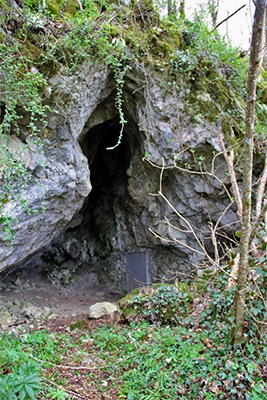
Present entrance to Trois-Frères.
Photo: © Michel31
Source: http://mototracteurs.forumactif.com/t27960-le-printemps-est-revenu
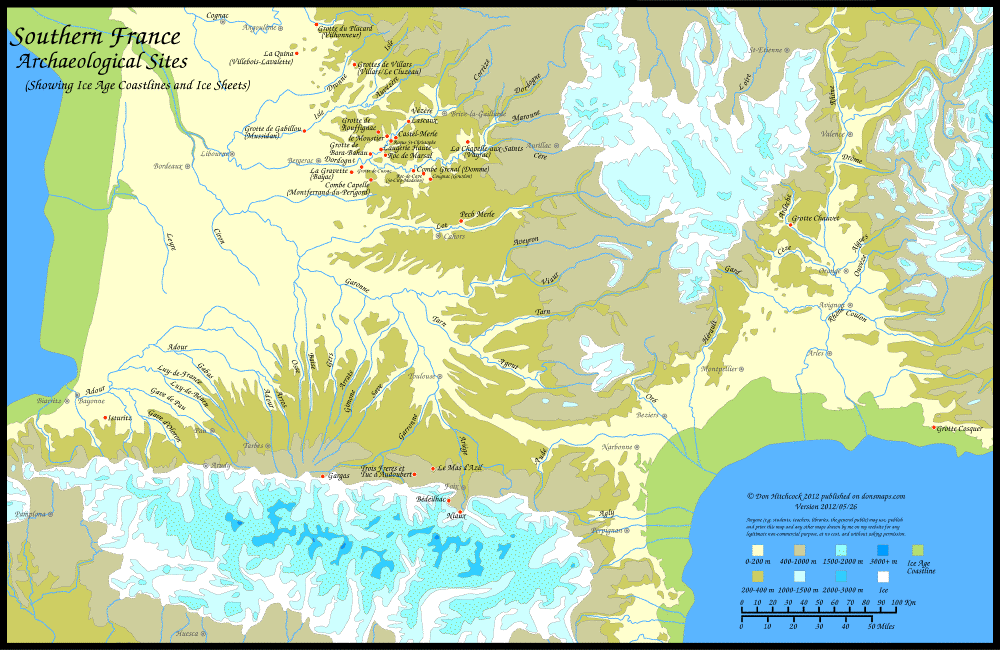
Note - Use this pdf file if you wish to print this map on a single sheet of paper.
Photo: Don Hitchcock version 2012/05/26

The Sorcerer.
Photo: Bégouën et al. (2014)
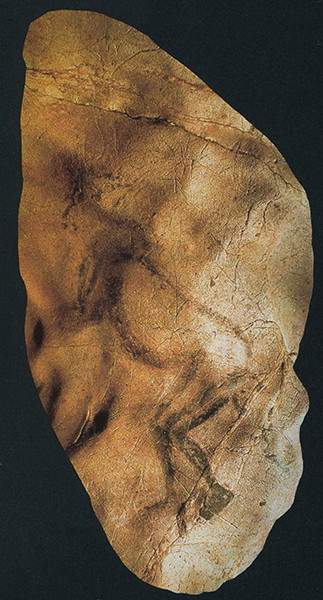
The Sorcerer.
Photo: J. Vertut. Collection Bégouën
Source: Leroi-Gourhan (1984)
Un dessin relevé dans la caverne des Trois-frères, à Montesquieu-Avantès (Ariège)
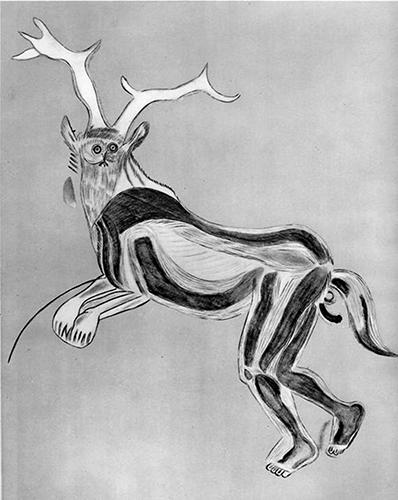
(note that this photo is from the original tracing by Breuil - Don )
This representation of a human figure is located on the end wall of the room that forms the end of the lower floor of the cave, more than 400 metres from the entrance, and in which are most of the engravings. We can mention only a few cats in a small diverticulum forming something of a chapel, and a large lion nearly two metres long, of terrifying aspect with his head facing the viewer, large eyes and a thick mane. It is engraved on the right wall a little in front of the niche and the stalagmite waterfall leading to the last room, it seems to defend the access.
This room presents itself as something of a shrine in which all niches, all corners, are overloaded with drawings of different size and technique, as well as age, as some like rhino and onager may be Aurignacian, while the majority is clearly magdalénienne. In the galleries of the upper floor, on the contrary, the Aurignacian era unquestionably dominates the drawings. These are far from achieving the perfection of the engravings of lower rooms, some of which, such as the reindeer engraved in a niche, just below the man, are treated with remarkable artistic feeling.
Through a twisting passage, whose walls are also decorated with plenty of horses, bears and other animals, one arrives at the design which we are presenting today.
It is then necessary to step over a gap, and by turning around a rocky point one is face to face with this bizarre figure.
It is about 75 cm high and 50 cm wide. It is fully engraved and the body parts are painted black. It seems that the paint was faded in some places, but the whole body was never painted. The forehead and eyes have traces of colour, as well as the lines delineating the nose.
A wide band marks the shoulders and back, another the belly. The legs are particularly carefully and well done. The left knee is indicated by a separate kneecap. The sexual organs shown thrust backwards, behind the buttocks, are strongly emphasised.
This drawing, despite the strangeness of its attitude, indubitably represents a naked man going to the left. At first glance, he seems to be crawling, but one soon realises he has just a strongly tilted forward tilted body and legs. The hands in fact do not have the motion of walking, but rather outline a beautiful action, as can be seen in the dances of some primitive peoples.
We find this same position in the human figures in les Combarelles. The buttocks are decorated with the tail of a horse. This tail is not in line with the line of the back as would a tail belonging to an animal's skin thrown over the body. It seems to have been stuck on to the posterior.
The head is particularly strange: a stag's antlers on the top of the head, with two long hairy and erect ears. Two eyes, formed of two engraved concentric circles between which the surface has been coloured black, and surrounding a white dot for a pupil, are placed symmetrically on either side of the nose, the widened part of which is marked by a painted and etched semicircle.
The cheekbone area is scraped up towards the ears. This same system of many parallel lines serves to indicate a long and elegant beard ten centimetres long, falling to the chest. The arms and hands are badly made, while the feet were drawn with care and fine strokes. The right hand has only four fingers, although they are more like claws.
The outline of both hands is recorded in a single curved line. The torso and lower limbs are shown by striated bands that define the contour.
Other scraped areas may be seen inside the body and limbs, for example the toes are separated from the instep of the foot by a scraped band. These scrapings and other engraved lines are visible only from close up, and we may wonder if they were once more visible when the rock was covered with a light clay deposit, present in other parts of the cave, that has since disappeared from this panel.
On other walls of the cave, where, being better sheltered, this layer was retained, the artists got wonderful artistic effects. The contour of the neck is formed by a triple row of oblique hatchings having the appearance of bristling horse hair. This is probably a piece of the pelt that accompanies the mask worn by a man, because this certainly is someone who is trying to stay hidden from clear view.
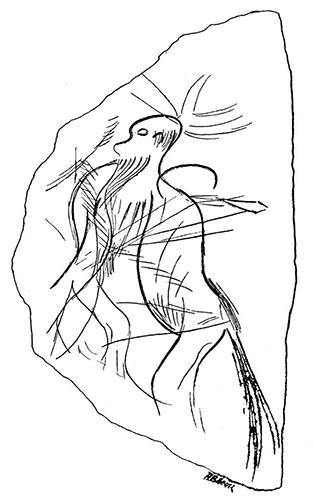
Of all the prehistoric documents to which we can compare this design, the most characteristic is an engraving on schist from Lourdes and in the Museum of Saint-Germain (No. 55522, collection Nelli).
A drawing by Abbé Breuil, reproduced here, allows us to see a man adorned with a big beard and a long tail. We even believe that the features we see above his head are antlers. So there would be an absolute correlation between this and the stone carving of the Three Brothers.
One possibility is that this represents a kind of divine being, another is that it is of a wizard. We believe that the artist wanted to represent a magician. For what purpose we do not know. Nothing allows us to guess his thoughts or his motivations. It seems that this artist was probably the sorcerer himself, wand he would have drawn his portrait with care and integrity, as a faithful rendering of his appearance during his rituals.
It is placed in the most remote corner of the lower cave, but on a wall overlooking the hundreds of animals that he or his colleagues have, for long sequences of generations , drawn to cast spells. Because in everything in this cave we talk about magic.
Most of the animals have arrows in their flank; others are surrounded or covered with these signs in the form of the letter P recalling the claviforms of Niaux and Altamira, and those found in the drawings of the Tuc d'Audoubert. They appear again here, sometimes in large numbers (there are up to twelve on one horse). At the bottom of the upper gallery, of difficult and even dangerous access, the same red painted sign occurs, forty centimetres high, like a trail of blood, above an arch.
Photo and text above: Bégouën (1920)
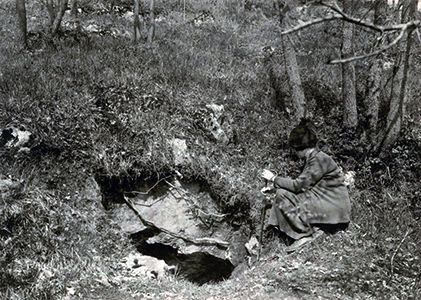
The sinkhole through which Trois-Frères was discovered in 1914, shown here in 1923 with Madame Louis Bégouën.
From the first, the decision was made to keep the caves closed to the public. At the end of 1983, 676 people had visited the Tuc d'Audoubert and 1192 had visited les Trois Frères.
This works out to only three or four visits of groups of people per year per cave.
Photo: Bégouën et al. (2014)
Additional text: Bégouën (1984)
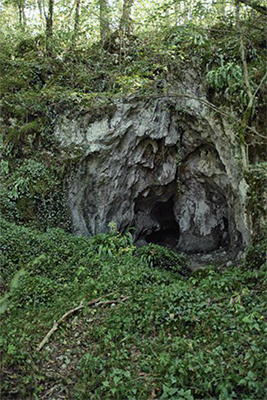
Present entrance to Trois Frères cave.
Photo: Bégouën et al. (2014)
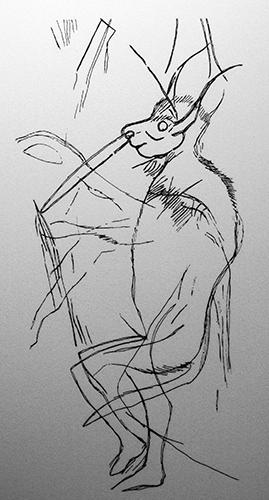
Person playing the nose flute, an engraving from la grotte des Trois-Frères, Ariège, after M. Dauvois
Photo: Don Hitchcock 2014
Source and text: Display, Musée d'Archeologie Nationale et Domaine, St-Germain-en-Laye
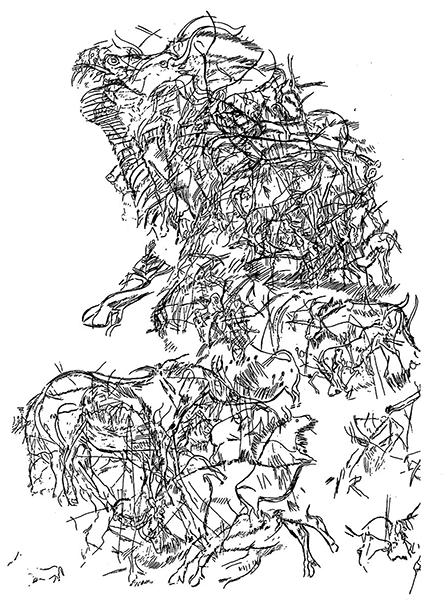
Engravings in Trois Freres.
Photo: Broglio (1998)

Panel of engravings on the right hand wall of the Sanctuary in Les Trois Freres.
Width of panel 285 cm.
Photo: Sieveking (1979)
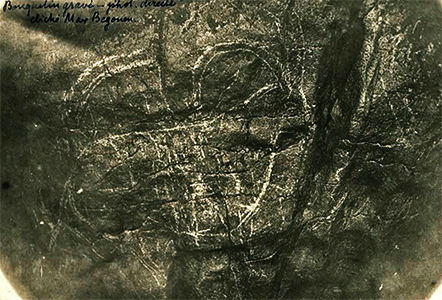
The large ibex from le Sanctuaire in 1918.
Photo: from a glass plate negative, by Max Bégouën
Source: Bégouën et al. (2014)
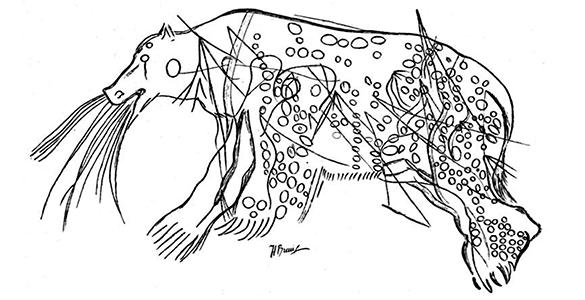
Engraving of a brown bear, Ursus arctos, riddled with spears and apparently vomiting blood, spotted like a panther.
Le Sanctuaire des Trois-Frères, length 60 cm.
Photo and text: Breuil (1930)

Le Sanctuaire des Trois-Frères, group of drawings, 38 cm wide, with three bear figures, one with the head of a wolf, and the other with the tail of a bison.
Photo and text: Breuil (1930)

Le Sanctuaire des Trois-Frères, man masked like a bison, playing a flute, preceded by a fantastic female animal with the hindquarters of a reindeer and the forequarters of a bison, as well as a female reindeer whose front legs are drawn like those of a duck, or which are meant to be like human arms.
Length 38 cm.
Photo and text: Breuil (1930)
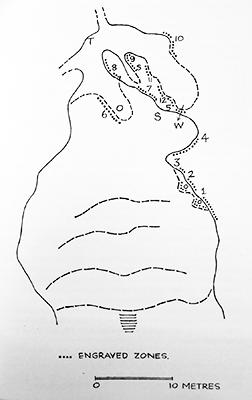
Map of engraved zones.
1: Small Bisons, 2: Mammoth, 3: Large ibex, 4: Reindeer (suspended), 5: Large bison, 6: First sorcerer frieze, 7: Rhinoceros, 8: Second small sorcerer, 9: Small reindeer engraved on the lower part of the overhang, 10: Bisons and horses, 11: Horses, 12: Small bears.
O: Overhang, S: Sorcerer, T: Tunnel, W: Window.
Photo and text: Sieveking et al. (1962)

Onager, Equus hemionus.
Length 510 mm.
Situated at the far end of the cave, in the Galerie de l'Hémione, the Onager Gallery.
Photo: J. Vertut, collection Bégouën
Source: Leroi-Gourhan (1984)
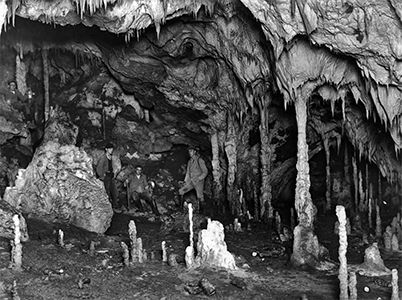
L'abbé Breuil and his aides, in la Salle du Théâtre.
Photo: Field Museum of Natural History, Chicago
Source: Bégouën et al. (2014)
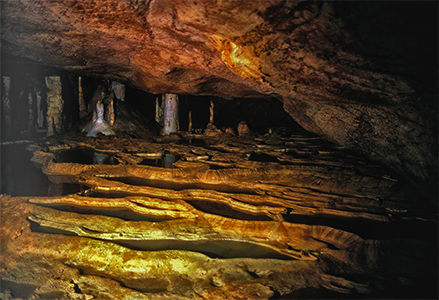
Salle des Gours after a rainy period.
Photo: Heinrich Wendel (© The Wendel Collection, Neanderthal Museum)
Source: Bégouën et al. (2014)

The Bégouën brothers in the sanctuary they discovered.
Figure of the sorcerer barely visible, upper centre.
Photo: Field Museum of Natural History, Chicago
Source: Pfeiffer (1995)
Large phallus at le Sanctuaire des Trois-Frères
The composition and complexity of the fantastic bestiary of the Sanctuary has not yet ceased to surprise us and pose new questions. In fact it took a new examination to notice a large engraved phallus in the middle of the first panel, situated just above a natural concavity in the wall which evokes the shape of a vulva (Fig. 1). We immediately asked ourselves how neither the Bégouën family nor other visitors over the course of almost a century, nor Breuil in his 18 years of work in the cave, noticed this figure which is nevertheless clearly visible upon arrival in the Sanctuary. To suspect them of prudery or even censorship does not seem credible. However, the precise position of the phallus, situated on an edge of the wall forming a near right angle, and separating two panels studied until then one after the other, might perhaps be a reason.Reading the right-hand panel is fairly difficult and less attractive than that of the preceding one with its mammoth, humans and arrow-marked bison. Perhaps the exceptional size of this engraving plays a part? It is much bigger than the surrounding drawings and necessitates standing back to understand it. The extremely delicate Magdalenian art of Les Trois-Frères cave has survived its first ‘public' century intact. To mark this centenary the publication of a study “Les Trois-Frères cave, an anthology and new finds” will provide an updated overview. Localisation and description of the phallus Breuil described the engraved panels of the Sanctuary from right to left (Bégouën et Breuil, 1958). The phallus is situated in the middle of the first part of the right-hand wall, at 1.2 m from the floor, at the intersection of the 3rd, 4th and 5th panels.
The whole of the engraving measures 59 cm long from the glans to the pubic triangle and from 7 to 11 cm wide.
Text above: Bégouën et Bégouën (2013b)
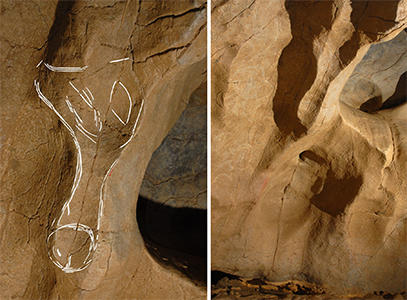
Le Sanctuaire des Trois-Frères
Drawing of a phallus, and an overview of the phallus and vulva, with a presentation of the reliefs which inspired the figures. Photo and drawings É. Bégouën.
Among the phallic representations recorded, the morphology seems realistic, although sometimes the dimensions are exaggerated, with the Bédeilhac phallus of 28 cm, or at Fronsac, where there is a phallus of 38 cm, but only at les Trois Frères do we find such an oversized representation. It is 59 cm in length, which may be compared to the other largest figure, a mammoth, which is only 53 cm. This disparity makes us wonder if the size is purely because of the space for it on the wall, or if the size is significant for other reasons.
Photo and text: Bégouën et Bégouën (2013a)
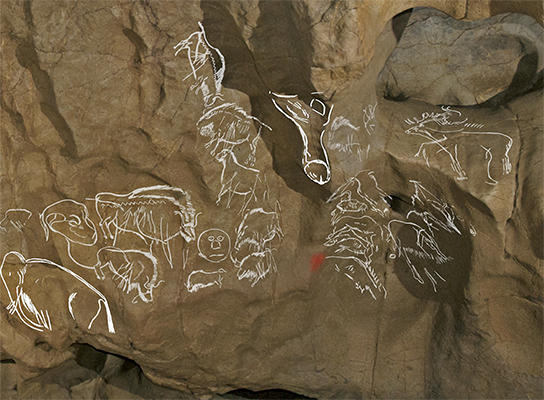
General view of the graphics context of the phallus panels 3, 4, 5 of le Sanctuaire des Trois-Frères.
Drawings by Breuil, photography and montage by É. Bégouën
Unlike other decorated caves of the Magdalenian, female representations are almost absent at les Trois Frères, except for what may be a vulva, while male representations are clearly present , including the Man-Bison, the small sorcerer with the nose flute, and of course the Sorcerer. This dominance emphasises the originality of the grotte des Trois-Frères. (Bégouën, 1929)
Photo and text: Bégouën et Bégouën (2013a)
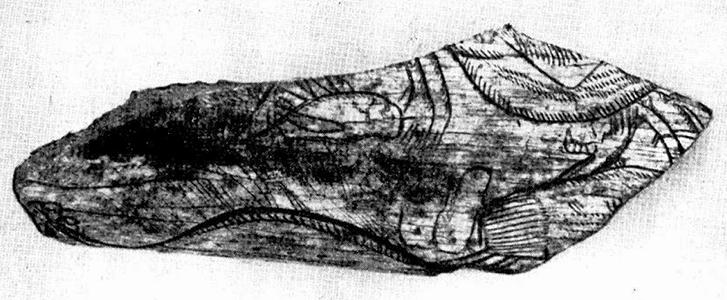
This was found at the junction of les Trois Frères with the Grotte d'Enlène, a large fragment of bison bone, on which are engraved four animals, indubitably birds, but it is impossible to work out their genus or species, not only because they are incomplete because of fracture, but because they are not realistic in their design. It should be recognised, however, that the birds have been treated with care and artistic ability that is rarely found in the representation of palaeolithic birds.
It is intriguing that bison, reindeer, horses and other large beasts are most often treated with a rare truth of expression, so why then do we find that when it comes to birds, a difference of technique so marked that it does not allow us to identify the species.
Photo and text: Bégouën (1929b)
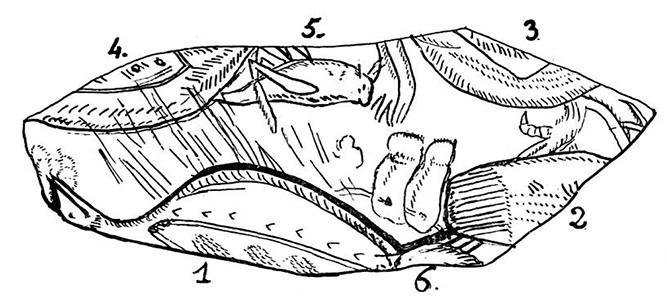
I thought first of all - and it was the opinion of the Abbé Breuil - that the leg, which is the single best treated part of this drawing was that of a grouse (No. 2). The tail also is reminiscent of the grouse found in the 'sphinx' of Mas d'Azil. On examination, I believe that the fourth finger back is too developed and too sharp a claw for Galliformes.
I rather think it might be a raptor. Another bird (No. 3) seems a waterfowl because of its dangling legs whose claws are not separated. A third (No. 1) could be a wader, because of the slender and long bare legs, but the neck and short beak, exclude the idea of cranes and storks, it is more likely to be a crake or a moorhen.
But the main interest of this piece is a small animal, (No. 5) which is at the centre of the drawing. It is, without doubt a cricket, with its big body, upright head, and especially his legs with strong thighs and jagged shanks . This is the first time to our knowledge, that an insect is featured in a prehistoric drawing.
Photo and text: Bégouën (1929b)
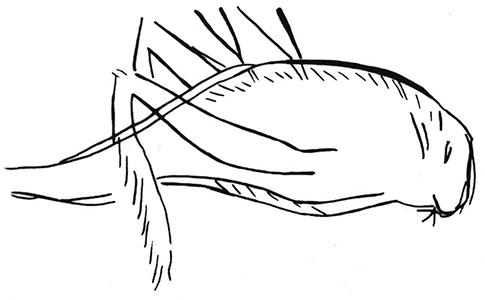
A closeup of the insect above, redrawn.
Photo: HTO
Permission: Public Domain
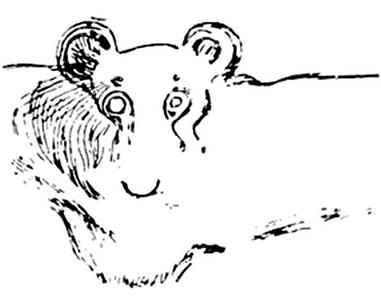
Lion head at Trois Frères.
Photo:
Sandars (1992)
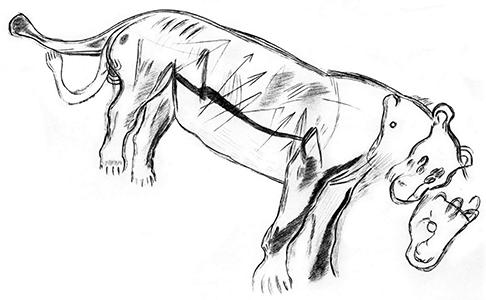
Lion at Trois Frères made up of several versions of the animal.
Photo: http://florentrivere.blogspot.com.au/2012_01_01_archive.html
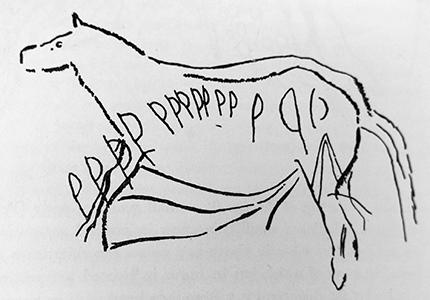
The horse immediately below the window ledge is engraved with a large series of claviform (club) symbols.
Photo and text: Sieveking et al. (1962)
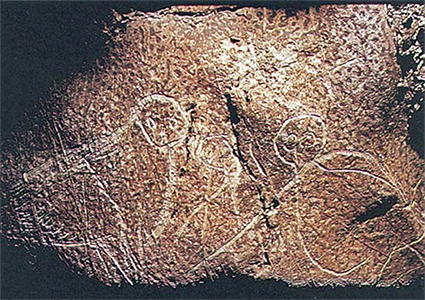
Engraved owls at Trois Frères.
Photo: R. Bégouën, in Lorblanchet (1995)
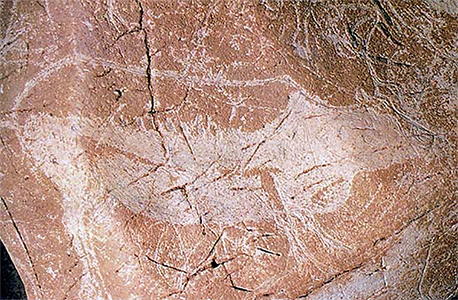
Engraved reindeer at Trois Frères.
Photo: R. Bégouën, in Lorblanchet (1995)
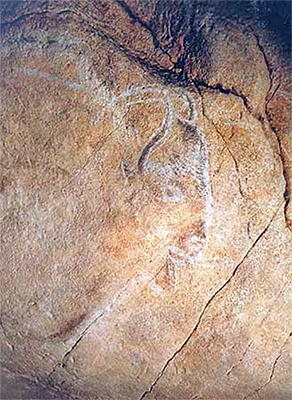
Engraved and painted bison at Trois Frères.
Photo: R. Bégouën, in Sacchi et al. (1996)
References
- Bégouën E., Bégouën M., 2013b:New discoveries in the Sanctuary of Les Trois-Frères cave (Ariège), Quartär , 60 (2013): 107-114
- Bégouën L., 1939: Pierres gravées et peintes de lépoque magdalénienne, Mélanges Bégouën, pp. 289-305
- Bégouën E., Bégouën M., 2013a: Découverte d'un grand phallus gravé magdalénien dans la grotte des Trois-Frères (Ariège), Bulletin de la Société Préhistorique Française , Tome 110, numéro 1, janvier-mars 2013, p. 127-129.
- Bégouën H., 1920: Un dessin relevé dans la caverne des Trois-frères, à Montesquieu-Avantès (Ariège), Comptes rendus des séances de l'Académie des Inscriptions et Belles-Lettres, 64e année, N. 4, 1920. pp. 303-310.
- Bégouën H., 1929: À propos de l'idée de fécondité dans l'iconographie préhistorique, Bulletin de la Société préhistorique française, 26, 3, pp 197-199.
- Bégouën H., Breuil H., 1958: Les cavernes du Volp , Paris, Ed. Arts et métiers graphiques, p. 10, 48, 77, 89.
- Bégouën R., 1984: Projet d'étude globale les cavernes du Volp, http://www.cavernesduvolp.com/Begouen_1984.pdf
- Bégouën R., Clottes J., 2008: Douze nouvelles plaquettes gravées d'Enlène, Espacio, Tiempo y Forma, Serie I, Nueva época. Prehistoria y Arqueología, t. 1, 2008. pp. 77-92
- Bégouën R., Clottes J., Feruglio V., Pastoors A., 2014: La caverne des Trois-Frères, Co-edition Louis Association Bégouën / Somogy Editions d'Art, 248 pp, 288 ill.
- Bégouën R., Fritz C., Tosello G., Clottes J., Faist F., Pastoors A., Lacombe S., Fosse P., 2007: Les Magdaléniens modelaient aussi l'argileLes Dossiers d'Archéologie, No. 324, November/December 2007
- Breuil H., 1930: Un dessin de la grotte des Trois frères (Montesquieu-Avantès) Ariège, Comptes rendus des séances de l'Académie des Inscriptions et Belles-Lettres, 74e année, N. 3, 1930. pp. 261-264.
- Broglio A., 1998: Introduzione al Paleolitico, Laterza, Bari 1998: 2006(6): p. 254;
- Giraud J., Rouzaud F., Bégouën R., Clottes J., 1982: Plaquette gravée d'Enlène, Montesquieu-Avantès (Ariège)Bulletin de la Société préhistorique française 1982, tome 79, N. 4. pp. 103-109.
- Guthrie, R.D., 2005: The nature of Paleolithic art Published by University of Chicago Press, 2005 ISBN 0226311260, 9780226311265 507 pages
- Leroi-Gourhan A., 1984: L'Art des cavernes : Atlas des grottes ornées paléolithiques françaises, Relié – 1 décembre 1984
- Lorblanchet, M., 1995: Les grottes ornées de la préhistoire : nouveaux regards Paris : Editions Errance, 1995.
- Pfeiffer, J., 1986: The Creative Explosion: An Inquiry into the Origins of Art and Religion, Horizon Book Promotions; 1st edition (November 1986)
- Sacchi, D., Vaquer J., 1996: Connaitre la prehistoire des Pyrenees Bordeaux : Sud Ouest, 1996.
- Sandars, N., 1992: Prehistoric Art in Europe Second Edition, The Yale University Press Pelican History, Paperback – November 25, 1992
- Sieveking, A., Sieveking G., 1962: The caves of France and northern Spain: a guide, London Vista Books, 1962
- Sieveking, A., 1979: Cave Artists (Ancient Peoples and Places)
Back to Don's Maps
 Back to Archaeological Sites
Back to Archaeological Sites